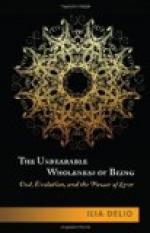In the East the worship of female divinities was older and more spontaneous than in the Western world, and thus the cult of Mary existed in the Orient long before it penetrated to Italy and thence into the newly Christianised countries. The Virgin, who for the first few hundred years had held a clearly defined position in evangelical history, had become an independent object of worship. Festivals were held in her honour; churches were dedicated to her; the will of the people triumphed in the litany; art took possession of the grateful subject. The tendency to make Mary the equal of Christ grew steadily. Metaphors originally intended for Christ alone were used indifferently for either. We constantly find her addressed as the “archetype, the light of the world, the vine, the mediator, the source of eternal life, etc.” Finally she ceased being regarded as a passive participator in the work of salvation, as the Mother of the Saviour, and was accredited with independent saving power. John of Damascus (eighth century) first called Mary [Greek: soteira tou chosmou], and soon after she was styled “Saviour of the World” in the Occident also. With this the cult of Mary had reached its third stage, the stage which interests us; she had become the object of metaphysical love. But before dealing with this third stage, we must glance, in passing, at the ancient Teutonic tribes. They, too, worshipped goddesses and sacred women; virginity, a virtue not appreciated by the Orientals, here stood in high repute. According to Tacitus and others, the Teutons looked upon the Virgin as a mysterious being, approaching divinity more closely than all others. Thus there was here, perhaps, more than on the shores of the Mediterranean, a favourable soil for the cult of Mary. The characteristics of Holda and Freya, as well as their perfect beauty, were transferred to Mary, and Mary’s name was substituted for the names of the old auxiliary goddesses. In the oldest German evangelical poems Mary does not yet rank as a divinity, she is merely extolled as the most perfect of all earth-born women. In the “Heliand” (about A.D. 830) she is called “the most beautiful of all women, the loveliest of all maidens”; and the monk Otfried, of Weissenburg (860), calls her, “Of all women to God the most pleasing, the white jewel, the radiant maid.”




